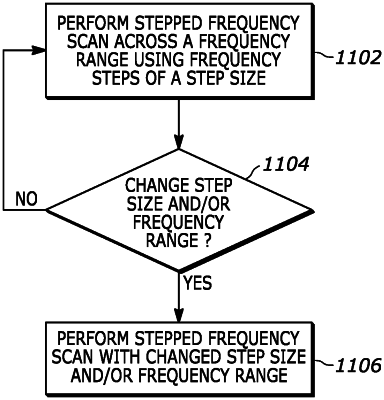| CPC G01S 13/24 (2013.01) [G01S 7/03 (2013.01); G01S 7/282 (2013.01); G01S 13/343 (2013.01); G01S 13/42 (2013.01); G01S 2013/0245 (2013.01)] | 11 Claims |

|
1. A method for operating a stepped frequency radar system, the method comprising:
receiving digital frequency control signals at a radio frequency (RF) front-end from a digital baseband system of the stepped frequency radar system, wherein the digital frequency control signals correspond to different frequencies of RF signals, and wherein the digital frequency control signals are received at the RF front-end at a fixed repetition interval, T, as N-bit binary values in which each N-bit binary value corresponds to a discrete frequency on a numeric range scale, wherein the numeric range scale is a function of an addressable frequency range of the stepped frequency radar system divided by a total number of discrete frequencies such that each discrete frequency in the addressable frequency range of the stepped frequency radar system is separated from its nearest discrete frequency by a fixed step size and such that each N-bit binary value corresponds to a discrete frequency in the range scale, wherein the N-bit binary values are received at the RF front-end as a time sequence of one N-bit binary value per fixed repetition interval, T, such that each N-bit binary value determines the discrete frequency for one fixed repetition interval, T; and
performing stepped frequency scanning across a frequency range using at least one transmit antenna and a two-dimensional array of receive antennas and RF signals at the different frequencies that correspond to the digital frequency control signals;
wherein the frequency range is changed from a first frequency range to a second frequency range, wherein the first frequency range and the second frequency range are separated by a third frequency range in which interfering RF energy exist;
wherein the third frequency range in which interfering RF energy exists is learned by first conducting a learning scan that involves scanning a frequency range that includes the first, the second, and the third frequency ranges with a power amplifier corresponding to the at least one transmit antenna deactivated during the entire learning scan; and
wherein discrete frequency pulses are distributed throughout the stepped frequency radar system during the learning scan except that amplified frequency pulses are not transmitted from the at least one transmit antenna because the power amplifier corresponding to the at least one transmit antenna id deactivated during the entire learning scan.
|